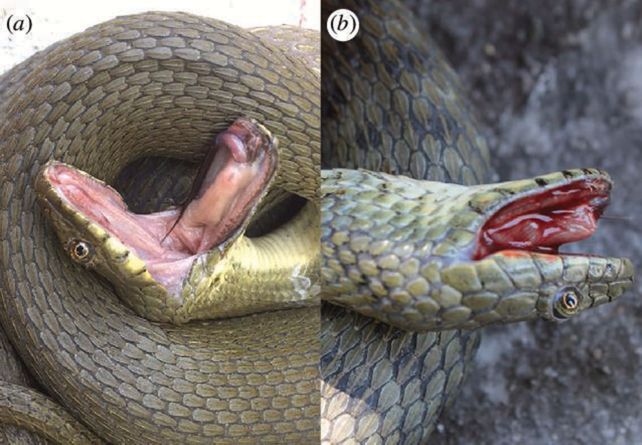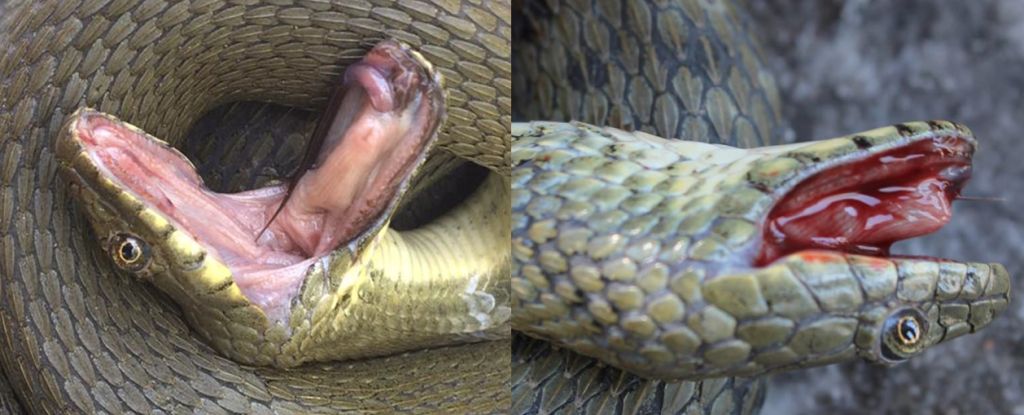Playing dead is a common defense strategy in the animal kingdom, but some especially melodramatic snakes have now been seen dialing it up to 11.
In addition to flopping inert, mouths agape, dice snakes (Natrix tessellata) add some amazingly gross special effects. They’ll defecate and smear themselves in feces, excrete stinky musk, and even start bleeding from the mouth, for what might be the most realistic deaths ever feigned in nature.
It may seem a bit over-the-top, but there’s a payoff. Scientists studying these top-tier acting skills found that adding a little something more allows the snake to escape more quickly, evading predation more adroitly than snakes that don’t go the extra mile.
“Our results,” write zoologists Vukašin Bjelica and Ana Golubović of the University of Belgrade in Serbia, “highlight the functional integration of antipredator behaviors across different phases of predator-prey interactions, emphasizing the need for future research to prioritize studying the sequential display of behaviors.”
A behavior known as apparent death – or tonic immobility – is actually quite common in nature, across a wide range of taxa. Its ubiquity suggests that it’s an effective defense against predators, although exactly why is unclear. Some research suggests that it’s often a last-ditch effort to escape after predator-prey contact has already occurred.
However it works, some snakes seem to have found a way to tip the odds even further in their favor. Eastern hog-nosed snakes (Heterodon platirhinos), for example, flip onto their backs, convulse, puke, and excrete musk. This is a foul-smelling substance produced in glands near the snake’s cloaca, like the anal glands of skunks.
Dice snakes – a non-venomous species that mainly eats fish – are known to have feces and musk among in their defensive toolkit; when alarmed, they struggle, hiss, and coat themselves in stench. They also play dead, and have been seen bleeding from the mouth using an ability known as autohemorrhaging.
These snakes have a habitat range that includes western Europe, and northern Africa, the Middle East, Central Asia and western China. They’re also considered a tasty snake to quite a number of predators, including reptiles, birds, and mammals.
Bjelica and Golubović wanted to know how this snake’s defenses work in the wild. They headed to the island of Golem Grad in Macedonia, where they set about sneaking up on and surprising snakes in their natural habitat.
They managed to harass 263 snakes, grabbing them around their midsection, and cataloging the response. Nearly half the snakes – 124 – pooped themselves (as you might, if you were just catching some rays and a giant suddenly grabbed you), while a much smaller number – 28 – bled from the mouth. And only snakes that feigned death also exhibited autohemorrhaging.

But something interesting happened when the researchers totted up the time each snake spent playing dead. The snakes that added flair to their death display spent approximately two seconds less time feigning death.
This suggests, the researchers say, that combining defense strategies confers added benefits to the snakes – those that put in the additional work get to go home sooner. We could, they say, learn a lot more about how animals defend themselves by studying how their behaviors work together.
“Our findings provide evidence for the functional integration of distinct antipredator behaviors across sequential phases of the predator-prey interaction (musking during the capture phase and death-feigning and autohemorrhaging during the post-capture phase),” the researchers write.
“Consequently, future research should prioritize examining the precise sequence of behaviors displayed during experiments rather than focusing on isolated displays.”
All snakes that participated in the study were released unharmed at the site of capture.
The research has been published in Biology Letters.





